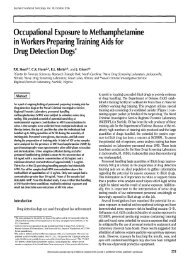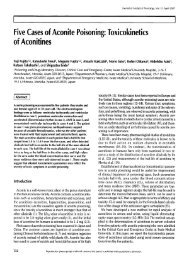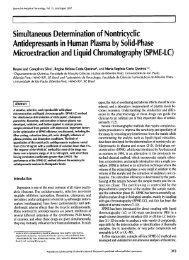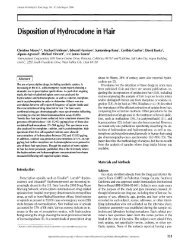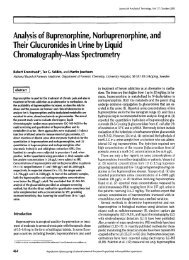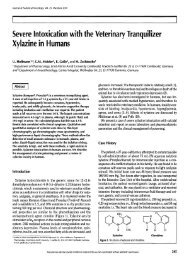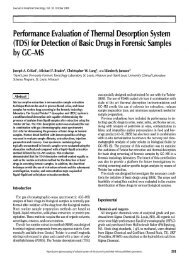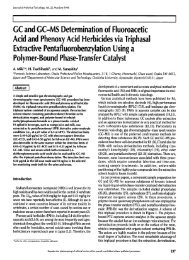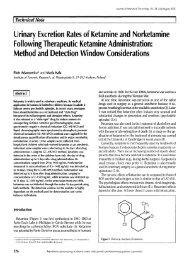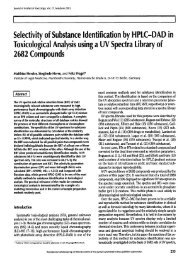Cyanide and Thiocyanate in Human Saliva by Gas - Journal of ...
Cyanide and Thiocyanate in Human Saliva by Gas - Journal of ...
Cyanide and Thiocyanate in Human Saliva by Gas - Journal of ...
You also want an ePaper? Increase the reach of your titles
YUMPU automatically turns print PDFs into web optimized ePapers that Google loves.
<strong>Journal</strong> <strong>of</strong> Analytical Toxicology, Vol. 30, October 2006<br />
<strong>Cyanide</strong> <strong>and</strong> <strong>Thiocyanate</strong> <strong>in</strong> <strong>Human</strong> <strong>Saliva</strong> <strong>by</strong><br />
<strong>Gas</strong> Chromatography-Mass Spectrometry<br />
Buddha D. Paul <strong>and</strong> Michael t. Smith<br />
Division <strong>of</strong> Forensic Toxicology, Office <strong>of</strong> the Armed Forces Medical Exam<strong>in</strong>er, Armed Forces Institute <strong>of</strong> Pathology,<br />
Rockville, Maryl<strong>and</strong> 20850<br />
r Abstract ]<br />
A method is described for simultaneous determ<strong>in</strong>ation <strong>of</strong> cyanide<br />
(CN) <strong>and</strong> thiocyanate (SCN) <strong>in</strong> human saliva, or oral fluid. SCN<br />
concentrations <strong>in</strong> body fluids appeared to be important <strong>in</strong><br />
classify<strong>in</strong>g patients as smokers or nonsmokers, <strong>in</strong> determ<strong>in</strong><strong>in</strong>g<br />
some cl<strong>in</strong>ical conditions, <strong>and</strong> <strong>in</strong> specimen validity test<strong>in</strong>g <strong>in</strong><br />
forensic drug test<strong>in</strong>g. The human saliva samples were diluted <strong>and</strong><br />
the anions were separated <strong>by</strong> an extractive alkylation technique.<br />
Tetrabutylammonium sulfate was used as phase-transfer catalyst<br />
<strong>and</strong> pentafluorobenzyl bromide as the derivatiz<strong>in</strong>g agent. The<br />
products were analyzed <strong>by</strong> a gas chromatography-mass<br />
spectrometry (GC-MS) with selected ion monitor<strong>in</strong>g method.<br />
2,5-Dibromotoluene was used as <strong>in</strong>ternal st<strong>and</strong>ard for quantitation<br />
<strong>of</strong> CN <strong>and</strong> SCN <strong>in</strong> saliva. The calibration plot was l<strong>in</strong>ear over the<br />
concentration range from 1 to 100 pmol/t (0.026-2.60 pg/mL) for<br />
CN (R = 0.9978) <strong>and</strong> 5 to 200 pmol/L (0.29-11.6 pg/mL) for SCN<br />
(R = 0.9996). The method was used to exam<strong>in</strong>e 10 saliva<br />
specimens. The concentration ranged from 4.8 to 29 pmol//<br />
(0.13-0.75 pg/mL) for CN <strong>and</strong> 293 to 1029 pmol/L (17-59.7<br />
pg/mL) for SCN. The SCN results were similar to those obta<strong>in</strong>ed<br />
from a method us<strong>in</strong>g oxidation <strong>of</strong> SCN to CN with colorimetric<br />
detection (R = 0.9882). The proposed GC-MS confirmatory<br />
method was found useful when the concentrations <strong>of</strong> CN <strong>and</strong> SCN<br />
<strong>in</strong> saliva needed to be accurately determ<strong>in</strong>ed.<br />
Introduction<br />
<strong>Thiocyanate</strong> (SCN) is usually present <strong>in</strong> serum, saliva, <strong>and</strong><br />
ur<strong>in</strong>e <strong>in</strong> low concentration (1--4). It is the pr<strong>in</strong>cipal metabolic<br />
product <strong>of</strong> cyanide (CN) metabolism. High concentration may<br />
be due to HCN <strong>in</strong>gestion from tobacco smoke <strong>and</strong> metabolic<br />
conversion to SCN (5,6). When sodium nitroprusside is used to<br />
treat a variety <strong>of</strong> cardiovascular conditions, SCN <strong>in</strong> plasma<br />
may <strong>in</strong>crease to a potentially toxic level (7). In contrast, a low<br />
concentration <strong>of</strong> 8CN <strong>in</strong> plasma <strong>of</strong> a tobacco smoker may con-<br />
firm a toxic amblyopia (8,9). Other cl<strong>in</strong>ical disorders like ataxic<br />
neuropathy (10), tropical diabetes (11), <strong>and</strong> endemic goiter <strong>and</strong><br />
cret<strong>in</strong>ism (12) may be due to elevated level <strong>of</strong> SCN <strong>in</strong> body<br />
fluids from <strong>in</strong>gestion <strong>of</strong> cyanogenic glycosides <strong>in</strong> cassava. Mea-<br />
surements <strong>of</strong> CN <strong>and</strong> SCN are <strong>of</strong> grow<strong>in</strong>g importance <strong>in</strong> mon-<br />
itor<strong>in</strong>g some cl<strong>in</strong>ical conditions <strong>and</strong> dist<strong>in</strong>guish<strong>in</strong>g tobacco<br />
smokers from nonsmokers.<br />
Many colorimetric methods have been reported for deter-<br />
m<strong>in</strong>ation <strong>of</strong> SCN (1,3,6,13-16) <strong>and</strong> CN <strong>in</strong> blood <strong>and</strong> plasma<br />
(17,18). The colorimetric methods for detect<strong>in</strong>g SCN are based<br />
on reaction between SCN <strong>and</strong> ferric nitrate as a chromogenic<br />
reagent (16) <strong>and</strong> the Konig reaction (19). Ion chromatography<br />
(IC) (20,21), gas chromatography (GC) (2,22-25), <strong>and</strong> high-<br />
performance liquid chromatography (HPLC) (26) were also<br />
used to detect SCN <strong>and</strong> CN <strong>in</strong> blood. SCN <strong>in</strong> saliva has been <strong>in</strong>-<br />
vestigated <strong>by</strong> color reaction (4), HPLC (27), flow <strong>in</strong>jection<br />
(28), IC (29,30), fourier transform <strong>in</strong>frared spectrometry (31),<br />
<strong>and</strong> capillary zone electrophoresis (32,33). In one procedure,<br />
CN <strong>and</strong> SCN were separated <strong>by</strong> a gas-phase diffusion tech-<br />
nique, transform<strong>in</strong>g the ions to the correspond<strong>in</strong>g chlorides <strong>by</strong><br />
chloram<strong>in</strong>e-T, <strong>and</strong> detect<strong>in</strong>g the products <strong>by</strong> a GC-MS method<br />
(34). The procedure required careful h<strong>and</strong>l<strong>in</strong>g <strong>of</strong> volatile com-<br />
ponents <strong>and</strong> had several reaction steps (CN-HCN-CNC1). We re-<br />
port here a GC-MS procedure for simultaneous determ<strong>in</strong>ation<br />
<strong>of</strong> CN <strong>and</strong> SCN <strong>in</strong> saliva, or oral fluid, after an extractive alky-<br />
lation us<strong>in</strong>g a phase-transfer catalyst. We also present the ef-<br />
fect <strong>of</strong> the phase-transfer catalysts on conversion <strong>of</strong> SCN to CN.<br />
Materials <strong>and</strong> Methods<br />
Chemical, reagents, <strong>and</strong> supplies<br />
Pentafluorobenzyl bromide (PFB-Br), 2,5-dibromotoIuene<br />
(2,5-DBT, <strong>in</strong>ternal st<strong>and</strong>ard), tetrabutylammonium sulfate<br />
(TBAS), sodium cyanide, <strong>and</strong> ammonium thiocyanate were<br />
purchased from Sigma-Aldrich (Milwaukee, WI). All solvents<br />
<strong>and</strong> reagents were <strong>of</strong> analytical or HPLC grade.<br />
Equipment<br />
A GC-MS system, consist<strong>in</strong>g <strong>of</strong> a 6890N GC <strong>and</strong> 5975 mass<br />
selective detector (MSD) from Agilent Technologies (Palo Alto,<br />
CA) was used. Helium was used as the carrier gas. The head<br />
pressure on the capillary column (15 m x 0.25-ram i.d. x 0.20<br />
]Jm, 5% phenyl polysiloxane, J&W Scientific, Rancho Cordova,<br />
Reproduction (photocopy<strong>in</strong>g) <strong>of</strong> editorial content <strong>of</strong> this journal is prohibited without publisher's permission. 5'[ I
CA) was 8-10 psi. The <strong>in</strong>strument was operated <strong>in</strong> splitless <strong>and</strong><br />
temperature program modes. To avoid peak tail<strong>in</strong>g, the purge<br />
valve was turned on at 0.50 ra<strong>in</strong> after sample <strong>in</strong>jection. The<br />
MSD was operated <strong>in</strong> electron impact mode at 70 eV. The de-<br />
tector was <strong>in</strong>itially <strong>of</strong>f <strong>and</strong> was turned on after a strong reagent<br />
peak <strong>of</strong> PFB-Br (approximately 3.0 ra<strong>in</strong>).<br />
Preparation <strong>of</strong> st<strong>and</strong>ards <strong>and</strong> reagents<br />
Stock solutions <strong>of</strong> CN <strong>and</strong> SCN were prepared at a concen-<br />
tration <strong>of</strong> 10 mmol/L <strong>in</strong> water. Work<strong>in</strong>g solutions <strong>of</strong> CN/SCN<br />
at concentrations <strong>of</strong> 0, 25, 50, <strong>and</strong> 100 IJmol/L <strong>in</strong> water were<br />
used for specimen analysis. An SCN control (200 IJmol/L <strong>in</strong><br />
water) was used to monitor artifact formation <strong>of</strong> CN. The<br />
phase-transfer catalyst (TBAS, 10 mmol/L) was prepared <strong>in</strong> a<br />
saturated solution <strong>of</strong> sodium borate (pH 9.2). Derivatiz<strong>in</strong>g<br />
agent (PFB-Br) <strong>and</strong> <strong>in</strong>ternal st<strong>and</strong>ard (2,5-DBT) were prepared<br />
<strong>in</strong> ethyl acetate at concentrations <strong>of</strong> 20 mmol/L <strong>and</strong> 50 ]Jmol/L,<br />
respectively. All solutions were stored at 2-5~ except the<br />
TBAS solution, which was left at room temperature. The<br />
reagents were stable for at least six months. For K6nig color<br />
reaction, 0.6 g <strong>of</strong> barbituric acid was dissolved <strong>in</strong> 10 mL <strong>of</strong> a<br />
mixture <strong>of</strong> pyrid<strong>in</strong>e <strong>and</strong> 1M hydrochloric acid (3:7, v/v). The<br />
solution had a short shelf-life <strong>and</strong> was prepared before the<br />
analysis.<br />
Preparation <strong>of</strong> saliva samples<br />
Ten unstimulated saliva (oral fluid) specimens were col-<br />
lected from three male (M1, M2, M3) <strong>and</strong> two female (F1, F2)<br />
nonsmok<strong>in</strong>g subjects who expectorated directly <strong>in</strong>to<br />
polypropylene collection tubes. The wait<strong>in</strong>g time was at least<br />
a week when collected from the same subject. Approximately<br />
3 mL <strong>of</strong> saliva was centrifuged at RCF 7300 xg for 30 ra<strong>in</strong>. For<br />
analysis, 0.5 mL <strong>of</strong> the clear solution was diluted to 5 mL with<br />
water for a 10-fold dilution.<br />
Extractive alkylation procedure<br />
Solutions <strong>of</strong> 0.3 mL <strong>of</strong> PFB-Br (20 mmol/L), 0.2 mL <strong>of</strong> 2,5-<br />
DBT (50 lJmol/L), <strong>and</strong> 0.8 mL <strong>of</strong> TBAS (10 mmol/L) were<br />
added to 0.2 mL <strong>of</strong> st<strong>and</strong>ards (CN/SCN 0, 25, 50, 100 ]Jmol/L),<br />
control (SCN 200 IJmol/L), <strong>and</strong> saliva specimens <strong>in</strong> 5-mL glass<br />
centrifuge tubes. The tubes were capped, vortex mixed for 1<br />
m<strong>in</strong>, <strong>and</strong> heated at 55~ for 30 ra<strong>in</strong> <strong>in</strong> a water bath. The solu-<br />
tions were centrifuged at RCF 1700 x g for 5 ra<strong>in</strong>, <strong>and</strong> ap-<br />
proximately 100 IJL <strong>of</strong> the clear ethyl acetate solutions was<br />
transferred <strong>in</strong>to screw-capped <strong>in</strong>jection vials.<br />
GC-MS analysis<br />
The oven temperature was <strong>in</strong>creased from 60~ (held for 1.0<br />
ra<strong>in</strong>) to 90~ at 10~ <strong>and</strong> then to 150~ at 30~<br />
Both <strong>in</strong>jector <strong>and</strong> detector were set at 200~ Ions monitored<br />
were as follows: m/z 207, 188, <strong>and</strong> 157 for PFB-CN; m/z 239,<br />
181, <strong>and</strong> 161 for PFB-SCN; m/z 250 <strong>and</strong> 169 for 2,5-DBT (IS).<br />
Electron multiplier was set 200 V above autotune. To enhance<br />
sensitivity, PFB-CN <strong>in</strong> one group <strong>and</strong> PFB-SCN <strong>and</strong> IS <strong>in</strong> an-<br />
other group were monitored. Approximately 1-3 IJL <strong>of</strong> the<br />
ethyl acetate solution was <strong>in</strong>jected onto the <strong>in</strong>strument. The<br />
retention times for PFB-CN, PFB-SCN, <strong>and</strong> 2,5-DBT were 3.37,<br />
5.16, <strong>and</strong> 5.41 ra<strong>in</strong>, respectively.<br />
512<br />
<strong>Journal</strong> <strong>of</strong> Analytical Toxicology, Vol. 30, October 2006<br />
K~nig color test for saliva specimens<br />
The procedure was the same as that used to test CN <strong>and</strong> SCN<br />
<strong>in</strong> blood with m<strong>in</strong>or modifications (18). A solution <strong>of</strong> 0.8 mL<br />
<strong>of</strong> perchloric acid (0.33 tool/L) was added to 0.2 mL <strong>of</strong> stan-<br />
dards (SCN 0, 25, 50, 100, 150 tJmol/L) <strong>and</strong> saliva specimens.<br />
After 2 ra<strong>in</strong> <strong>of</strong> oxidation <strong>of</strong> SCN to CN, 0.2 mL <strong>of</strong> sodium ac-<br />
etate (1M) <strong>and</strong> 60 IJL <strong>of</strong> sodium hypochlorite (50 mmol/L)<br />
were added to the solutions. The so]ution was mixed, <strong>and</strong><br />
with<strong>in</strong> a m<strong>in</strong>ute, 0.2 mL <strong>of</strong> barbituric acid-pyrid<strong>in</strong>e reagent<br />
was added. After 5 ra<strong>in</strong>, the absorbance was recorded at 583<br />
nm. The <strong>in</strong>strument was set to zero us<strong>in</strong>g a water blank prior<br />
to analysis <strong>of</strong> specimens.<br />
Results <strong>and</strong> Discussion<br />
In extractive alkylation, CN <strong>and</strong> SCN <strong>in</strong> an aqueous solution<br />
reacted poorly with PFB-Br <strong>in</strong> ethyl acetate. But with the use<br />
<strong>of</strong> TBAS as a phase-transfer catalyst the reaction began im-<br />
mediately (CN ~ PFB-CN, SCN ~ PFB-SCN). After 30 m<strong>in</strong> <strong>of</strong><br />
reaction, the total ion chromatogram (TIC) areas were greater<br />
than 177,000 <strong>and</strong> 25,000 after an on-column <strong>in</strong>jection <strong>of</strong> 5 pi-<br />
comol (0.29 ng) <strong>of</strong> SCN <strong>and</strong> 12.5 picomol (0.33 ng) <strong>of</strong> CN, re-<br />
spectively. In both cases the background was less than 1%. The<br />
reactions were studied over a period <strong>of</strong> 120 ra<strong>in</strong>. When moni-<br />
tored <strong>by</strong> ion/IS ratios, the reactions were almost complete<br />
after 90 ra<strong>in</strong> for both CN <strong>and</strong> SCN. Because <strong>of</strong> the excellent on-<br />
column sensitivity, we ran the reaction for only 30 ra<strong>in</strong>. At this<br />
reaction time, the yield was 55-65% for both CN <strong>and</strong> SCN. In<br />
GC-MS analysis, three ions from PFB-CN <strong>in</strong> one group <strong>and</strong><br />
Table I. <strong>Cyanide</strong> <strong>and</strong> <strong>Thiocyanate</strong> (pmol/L) <strong>in</strong> Ten <strong>Saliva</strong><br />
Specimens Collected from Three Male (M) <strong>and</strong> Two<br />
Female (F) Nonsmok<strong>in</strong>g Subjects*<br />
Colorimetric<br />
GC-MS Method Method<br />
(CN + SCN) CN/SCN (CN + SCN)<br />
<strong>Saliva</strong> CN SCN pmol/L % pmol/L<br />
M1-1 29 794 823 3.7 929<br />
M1-2 11 442 453 2.5 555<br />
M1-3 12 741 753 1.6 825<br />
M1-4 8.2 1029 1037 0.8 1056<br />
M1-5 5.7 595 601 1.0 634<br />
M2-1 4.8 293 298 i .6 323<br />
M3-1 8.8 463 472 1.9 494<br />
F1-1 6.9 726 733 1.0 797<br />
F1-2 15 771 786 1.9 815<br />
F2-1 17 573 590 3.0 615<br />
M<strong>in</strong> 4.8 293 298 0.8 323<br />
Max 29 1029 1037 3.7 1056<br />
Median 9.9 661 667 1.8 716<br />
Average 11.8 643 655 1.9 704<br />
Std 7.2 213 215 0.9 220<br />
* Method comparison for (CN + SCN), <strong>in</strong>tercept = -26.7, slope = 0.9673,<br />
r = 0.9882.
<strong>Journal</strong> <strong>of</strong> Analytical Toxicology, Vol. 30, October 2006<br />
three ions from PFB-SCN <strong>and</strong> two ions from IS <strong>in</strong> another<br />
group were monitored. The identification <strong>of</strong> the compounds<br />
was based on compar<strong>in</strong>g retention times ( 2%) <strong>and</strong> relative<br />
ion abundances ( 20%) with the reference compounds. Ex-<br />
cellent l<strong>in</strong>earities were observed over the concentration range<br />
<strong>of</strong> i to 100 lamol/L (0.026-2.60 pg/mL) for CN <strong>and</strong> 5 to 200<br />
lamol/L (0.29-11.6 lag/mL) for SCN. The <strong>in</strong>tercept, slope, <strong>and</strong><br />
correlation coefficient were -0.0073, 0.9933, <strong>and</strong> 0.9978 for CN<br />
<strong>and</strong> 0.0695, 0.0.9989, <strong>and</strong> 0.9996 for SCN, respectively. In-<br />
terrun variations <strong>of</strong> ion/IS ratios were less than 11% (N = 5).<br />
The procedure was used to exam<strong>in</strong>e 10 saliva specimens<br />
collected from 3 male (M) <strong>and</strong> 2 female (F) subjects. <strong>Saliva</strong> <strong>in</strong><br />
our study is used synonymously with oral fluid to rema<strong>in</strong> con-<br />
sistent with term<strong>in</strong>ology <strong>in</strong> past publications. The specimens<br />
were <strong>in</strong>itially centrifuged, <strong>and</strong> the clear solutions diluted 10-<br />
Table II. Literature Reported <strong>Thiocyanate</strong> Concentrations<br />
<strong>in</strong> <strong>Saliva</strong> from Nonsmokers<br />
SCN mmol/L<br />
Reference Methods Average -+ SD Range N<br />
4 Colorimetric* 0.54 + 0.41 20<br />
30 IC 0.51 + 0.31 10<br />
31 FT-IR 0.83 + 0.42 0.41-1.25 25<br />
32 CZE 0,23-1.20 48<br />
Present method GC-MS 0.66 + 0.22 0,30-1.04 10<br />
Present method Colorimetric 0.70 + 0.22 0.32-1,06 10<br />
* For colorimetric method, the amounts represent (CN + SCN).<br />
l,ge+0<br />
1.6e+0<br />
1.4r<br />
1.2e+0<br />
lc+07<br />
~c+06<br />
6c+06<br />
4e+06<br />
2e+05<br />
! 3+§ to.~9.~ /<br />
l+Fo<br />
4,+ 1o. tlt~<br />
+i .......... I .......<br />
9 . .~. +, ,.+..*++ .<br />
.... t t +<br />
. . . . . 72 ......<br />
~lxii t 1+4 n.,,r<br />
%<br />
3.1s i';-/ '~s ' '3':C L~i<br />
5.16 PFB-SCN<br />
5.41 I5<br />
3.37 PFB-CN<br />
+ A<br />
3.20 3.40 3.60 3.80 4.00 4.20 4,40 4.60 4.80 5.00 5.20 5.40 5.60 5,80<br />
Time (m<strong>in</strong>)<br />
Figure 1. Total ion chromatogram (TIC) <strong>and</strong> selected ion monitor<strong>in</strong>g (SIM) <strong>of</strong> CN as PFB-CN (RT<br />
3.374 ra<strong>in</strong>, 5.7 +stool/L) <strong>and</strong> SCN as PFB-SCN (RT 5.16 ra<strong>in</strong>, 595 tJmol/L) from a saliva specimen<br />
(M1-5). 2,5-Dibromotoluene was used as <strong>in</strong>ternal st<strong>and</strong>ard (IS, RT 5.41 ra<strong>in</strong>).<br />
fold before test<strong>in</strong>g. The results are recorded <strong>in</strong> Table I. The<br />
method was verified <strong>by</strong> test<strong>in</strong>g the same specimens <strong>by</strong> a col-<br />
orimetric method used to test SCN <strong>and</strong> CN <strong>in</strong> blood (18). In<br />
the procedure the SCN was oxidized to CN <strong>and</strong> tested <strong>by</strong> the<br />
Kgnig procedure. Therefore, the result <strong>in</strong>dicated total <strong>of</strong> CN<br />
<strong>and</strong> SCN. The total CN <strong>and</strong> SCN values between the two<br />
methods compared favorably (r = 0.9882). In all cases, the<br />
values <strong>in</strong> GC-MS were less than those <strong>of</strong> the colorimetric<br />
method (<strong>in</strong>tercept = -26.7 pmol/L). This difference may be due<br />
to an <strong>in</strong>crease <strong>in</strong> background absorbance from the saliva ma-<br />
trix. The SCN concentrations found <strong>in</strong> our experiments are<br />
similar to those published <strong>in</strong> the literature (Table II). Consid-<br />
erable variation was observed <strong>in</strong> specimens collected from the<br />
same subject (M1, 442-1029 pmol/L). Generally, the amount<br />
<strong>of</strong> CN <strong>in</strong> all specimens was low (average 11.8 pmol/L) <strong>and</strong><br />
varied <strong>in</strong> the range <strong>of</strong> 0.8-3.7% <strong>of</strong> SCN. The ion chromatogram<br />
<strong>of</strong> specimen M1-5 is presented <strong>in</strong> Figure 1.<br />
L<strong>in</strong>earity <strong>and</strong> precision <strong>of</strong> CN <strong>and</strong> SCN were verified <strong>in</strong><br />
saliva. A sample (F2-1) was tested at 5, 10, 15, 20-fold dilutions.<br />
The correspond<strong>in</strong>g f<strong>in</strong>al concentrations were 20.0, 16.5, 15.4,<br />
<strong>and</strong> 15 t~mol/L (average 16.7 _+ 14%) for CN <strong>and</strong> 600, 573,<br />
597, <strong>and</strong> 607 lJmol/L (average 594 2.5%) for SCN. Two more<br />
specimens also gave similar results (M3-1, CN 7.9 + 11%, SCN<br />
477 + 3.9%, <strong>and</strong> F1-2, CN 11.4 + 1.5%, SCN 827 ___ 9.2%). For<br />
precision, M1-5 was tested <strong>in</strong> five replicates. The average +<br />
CV% were 5.7 11.6% for CN <strong>and</strong> 595 4.3% for SCN. It ap-<br />
peared that salivary concentrations <strong>of</strong> CN <strong>and</strong> SCN determ<strong>in</strong>ed<br />
<strong>by</strong> this method were l<strong>in</strong>ear <strong>and</strong> reproducible.<br />
<strong>Cyanide</strong> was reported as an artifact when SCN was deriva-<br />
tized under a basic condition (35). A basic condition was also<br />
used to determ<strong>in</strong>e CN <strong>and</strong> SCN <strong>in</strong> blood (25).<br />
In this method, SCN was derivatized <strong>in</strong> pres-<br />
ence <strong>of</strong> benzyldimethyltetradecylammonium<br />
chloride (BDM-TDA) as a phase-transfer cata-<br />
lyst. We studied the BDM-TDA method <strong>and</strong><br />
monitored the artifact formation <strong>of</strong> CN from<br />
SCN. Solutions <strong>of</strong> SCN (0.8 mL, 25-200<br />
pmol/L) were mixed with 0.3 mL <strong>of</strong> PFB-Br<br />
(20 retool/L), 0.2 mL <strong>of</strong> 2,5-DBT (IS, 50<br />
1Jmol/L), <strong>and</strong> 0.8 mL <strong>of</strong> BDM-TDA (5 mmol/L<br />
<strong>in</strong> saturate sodium borate <strong>in</strong> water, pH 9.2)<br />
<strong>and</strong> heated at 55~ for 30 m<strong>in</strong>. In the GC-MS<br />
chromatogram, a peak <strong>of</strong> CN was observed.<br />
The artifact CN concentrations were 7.2-9.2%<br />
<strong>of</strong> SCN (average 8.5 _+ 9%), compared to only<br />
0-0.34% <strong>by</strong> the TBAS method. Moreover,<br />
when tested <strong>by</strong> the BDM-TDA method, the<br />
amount <strong>of</strong> CN <strong>in</strong>creased with <strong>in</strong>creas<strong>in</strong>g time<br />
<strong>of</strong> reaction. No significant change was ob-<br />
served with the TBAS method. It <strong>in</strong>dicated<br />
that the small amount <strong>of</strong> CN detected <strong>by</strong> the<br />
TBAS was not an artifact but an impurity pre-<br />
sent <strong>in</strong> the commercial SeN. Artifact forma-<br />
tion <strong>of</strong> CN from SeN was also monitored <strong>in</strong><br />
specimen analysis. When specimen F2-1 was<br />
tested <strong>by</strong> the BMD-TDA method, the CN <strong>and</strong><br />
SeN concentrations were 86 <strong>and</strong> 514 pmol/L,<br />
respectively, compared to 17 <strong>and</strong> 573 pmol/L,<br />
513
espectively, <strong>by</strong> the TBAS method (Table I). St<strong>and</strong>ard solutions<br />
<strong>of</strong> CN <strong>and</strong> SCN were stable <strong>in</strong> water for at least 2 months. In<br />
different batch analysis, the ratios <strong>of</strong> CN/IS or SCN/IS were<br />
with<strong>in</strong> + 20%. Both CN <strong>and</strong> SCN were stable <strong>in</strong> saliva stored at<br />
2--4~ for 7 days. When six specimens were tested aga<strong>in</strong>, the re-<br />
sults were with<strong>in</strong> _+ 20% <strong>of</strong> the orig<strong>in</strong>al values.<br />
Three previously published studies found concentrations <strong>of</strong><br />
SCN <strong>in</strong> saliva <strong>of</strong> smokers to be 1655 +_ 841 IJmol/L (N = 20),<br />
3620 _+ 1720 tJmol/L (N = 5), <strong>and</strong> 2050 _+ 450 lJmol/L (N = 3)<br />
(4,28,33). These concentrations are much higher than those<br />
found for nonsmokers <strong>in</strong> this study, 655 _+ 215 IJmol/L. In a<br />
study <strong>of</strong> smokers with toxic amblyopia, the <strong>in</strong>vestigators found<br />
that plasma SCN concentrations returned to the nonsmoker<br />
range due to an <strong>in</strong>ability to convert CN to SCN (8,9,15). Other<br />
cl<strong>in</strong>ical abnormalities have also been reported <strong>in</strong> <strong>in</strong>dividuals<br />
who <strong>in</strong>gest cassava <strong>and</strong> have elevated plasma levels <strong>of</strong> SCN<br />
(10-12). It has also been proposed that identify<strong>in</strong>g endoge-<br />
nous components <strong>of</strong> saliva, such as CN <strong>and</strong> SCN, could be<br />
used to prove that specimens collected <strong>in</strong> drug test<strong>in</strong>g pro-<br />
grams are valid (36). One would expect that these various<br />
groups could be dist<strong>in</strong>guished based on CN <strong>and</strong> SCN concen-<br />
trations <strong>in</strong> their saliva.<br />
Conclusions<br />
Both CN <strong>and</strong> SCN are present <strong>in</strong> body fluids <strong>in</strong> different<br />
amounts. The validated GC-MS procedure presented here de-<br />
tects CN <strong>and</strong> SCN <strong>in</strong> saliva as low as 1.0 <strong>and</strong> 5.0 IJmol/L, re-<br />
spectively. In 10 specimens, the CN <strong>and</strong> SCN concentrations<br />
ranged from 4.8 to 29 lJmol/L <strong>and</strong> 293 to 1029 IJmol/L, re-<br />
spectively. The CN concentration was 0.8-3.7% <strong>of</strong> the SCN<br />
concentration. The saliva SCN concentrations found <strong>in</strong> this ex-<br />
periment were comparable with other literature procedures,<br />
support<strong>in</strong>g validity <strong>of</strong> the GC-MS method. The procedure may<br />
be useful <strong>in</strong> forensic drug test<strong>in</strong>g when specimen validity<br />
test<strong>in</strong>g is required <strong>and</strong> also <strong>in</strong> classify<strong>in</strong>g patients as smokers<br />
or non-smokers.<br />
References<br />
1. G.E. Boxer <strong>and</strong> J.C. Rickards. Determ<strong>in</strong>ation <strong>of</strong> thiocyanate <strong>in</strong><br />
body fluids. Arch. Biochem. Biophys. 39:292-300 (1952).<br />
2. J.C. Valentour, V. Aggarwal, <strong>and</strong> 1. Sunsh<strong>in</strong>e. Sensitive gas chro-<br />
matographic determ<strong>in</strong>ation <strong>of</strong> cyanide. Anal. Chem. 46:924-925<br />
(1974).<br />
3. R Lundquist, J. Martensson, B. Sorbo, <strong>and</strong> S. Ohman. Method for<br />
determ<strong>in</strong><strong>in</strong>g thiocyanate <strong>in</strong> serum <strong>and</strong> ur<strong>in</strong>e. Cl<strong>in</strong>. Chem. 25:<br />
678-681 (1979)<br />
4. K. Tsuge, M. Kataoka, <strong>and</strong> Y Seto. <strong>Cyanide</strong> <strong>and</strong> thiocyanate <strong>in</strong><br />
blood <strong>and</strong> saliva <strong>of</strong> healthy adult volunteers. J. Health Sci. 46:<br />
343-350 (2000)<br />
5. RM. Densen, B. Davidow, H.E. Bass, <strong>and</strong> E.W. Jones. A chemical<br />
test for smok<strong>in</strong>g exposure. Arch. Environ. Health 14:865-874<br />
(1976).<br />
6. W.C. Butts, M Kuehneman, <strong>and</strong> G.M. Widdowson. Automated<br />
method for determ<strong>in</strong><strong>in</strong>g serum thiocyanate to dist<strong>in</strong>guish smokers<br />
from nonsmokers. Cl<strong>in</strong>. Chem. 20:1344-1348 (1974).<br />
514<br />
<strong>Journal</strong> <strong>of</strong> Analytical Toxicology, Vol. 30, October 2006<br />
7. R.R Smith <strong>and</strong> H. Kruszyna. Nitroprusside propduces cyanide poi-<br />
son<strong>in</strong>g via a reaction with hemoglob<strong>in</strong>. J. Pharmacol. Exp. Ther.<br />
191:557-563 (I974).<br />
8. J. Wilson. Liber's hereditary optic atrophy: a possible defect <strong>of</strong><br />
cyanide metabolism. Cl<strong>in</strong>. Sci. 29:505-515 (1965).<br />
9. W.S. Foulds, J.M. Bronte-Stewart, <strong>and</strong> I.A. Chisholm. Serum thio-<br />
cyanate concentration <strong>in</strong> tobacco amblyopia. Nature 218:586<br />
(1968)<br />
10. B.O. Osuntokun. Cassava diet, chronic cyanide <strong>in</strong>toxication <strong>and</strong><br />
neuropathy <strong>in</strong> Nigerian Africans. World Rev. Nutr. Diet 36:<br />
141-173 (1981).<br />
11. D.E. McMillan <strong>and</strong> P.J. Geevarghese. Dietary cyanide <strong>and</strong> tropical<br />
malnutrition diabetes. Diabetes Care 2.' 202-208 (1979)<br />
12. F. Delange, V.D. Velden, <strong>and</strong> A.M. Ermans. Evidence <strong>of</strong> an an-<br />
tithyroid action <strong>of</strong> cassava <strong>in</strong> man <strong>and</strong> <strong>in</strong> animals. In Chronic Cas-<br />
sava Toxicity, B. Nestel <strong>and</strong> R.M. Maclntyre, Eds. Int. Devel. Res.<br />
Centre, Ottawa, Canada, 1973, pp 147-151.<br />
13. C.J. Vesey <strong>and</strong> C.J.C. Kirk. Two automated methods for mea-<br />
sur<strong>in</strong>g plasma thiocyanate compared. Cl<strong>in</strong>. Chem. 95:270-274<br />
(1985)<br />
14. N. Grgur<strong>in</strong>ovich. A colorimetric procedure for the determ<strong>in</strong>ation<br />
<strong>of</strong> thiocyanate <strong>in</strong> plasma. J. Anal. Toxicol. 6:53-55 (1982)<br />
15. A.R. Pettigrew <strong>and</strong> G.S. Fell. Simplified colorimetric determ<strong>in</strong>a-<br />
tion <strong>of</strong> thiocyanate <strong>in</strong> biological fluids, <strong>and</strong> its application to <strong>in</strong>-<br />
vestigation <strong>of</strong> the toxic amblyopias. Cl<strong>in</strong>. Chem. 18:996-1000<br />
(1972)<br />
16. R.G. Bowler. The determ<strong>in</strong>ation <strong>of</strong> thiocyanate <strong>in</strong> blood serum.<br />
Biochem. J. 38:385-388 (1944)<br />
17. P. Lundquist, H. Rosl<strong>in</strong>g, <strong>and</strong> B. Sorbo. Determ<strong>in</strong>ation <strong>of</strong> cyanide<br />
<strong>in</strong> whole blood, erythrocytes, <strong>and</strong> plasma. Cl<strong>in</strong>. Chem. 31:<br />
591-595 (1985)<br />
18. P. Lundquist <strong>and</strong> B. Sorbo. Rapid determ<strong>in</strong>ation <strong>of</strong> toxic cyanide<br />
concentrations <strong>in</strong> blood. Cl<strong>in</strong>. Chem. 35:617-619 (1989)<br />
19. W.J. K6nig. Untersuchungen aus dem organischen Jaboratorium<br />
der technischen hochschule zu dresen. LXlX. Uber e<strong>in</strong>e neue,<br />
vom pyrid<strong>in</strong> deriveirende, klasse von farbst<strong>of</strong>fen. Prakt. Chem. 69'<br />
105-137 (1904)<br />
20. Y. Michigami, T. Takahashi, F. He, Y. Yamamoto, <strong>and</strong> K. Ueda. De-<br />
term<strong>in</strong>ation <strong>of</strong> thiocyanate <strong>in</strong> human serum <strong>by</strong> ion chromatog-<br />
raphy. Analyst 113:389-392 (1988)<br />
21. S. Ch<strong>in</strong>aka, N. Takayama, Y. Michigami, K. Ueda. Simultaneous<br />
determ<strong>in</strong>ation <strong>of</strong> cyanide <strong>and</strong> thiocyanate <strong>in</strong> blood <strong>by</strong> ion chro-<br />
matography with fluorescence <strong>and</strong> ultraviolet detection. J. Chro-<br />
matogr. B 713:353-359 (1998)<br />
22. J. Zamecnik <strong>and</strong> J. Tam. <strong>Cyanide</strong> <strong>in</strong> blood <strong>by</strong> gas chromatography<br />
with NP detector <strong>and</strong> acetonitrile as <strong>in</strong>ternal st<strong>and</strong>ard. Application<br />
on air accident fire victims. J. Anal. Toxicol. 11 : 47-48 (1987)<br />
23. C. Maseda, K. Matsubara, <strong>and</strong> H. Shiono. Improved gas chro-<br />
matography with electron-capture detection us<strong>in</strong>g a reaction pre-<br />
column for the determ<strong>in</strong>ation <strong>of</strong> blood cyanide: a higher content<br />
<strong>in</strong> the left ventricle <strong>of</strong> fire victims. J. Chromatogr. 490:319-327<br />
(1989)<br />
24. Y. Seto, N. Tsunoda, H. Ohta, <strong>and</strong> T. Sh<strong>in</strong>ohara. Determ<strong>in</strong>ation <strong>of</strong><br />
blood cyanide <strong>by</strong> headspace gas chromatography with nitrogen-<br />
phosphorus detection <strong>and</strong> us<strong>in</strong>g a megabore capillary column.<br />
Anal. Chim. Acta 276:247-259 (1993)<br />
25. S. Kage, T. Takeaki, <strong>and</strong> K. Kudo. Determ<strong>in</strong>ation <strong>of</strong> cyanide <strong>and</strong><br />
thiocyanate <strong>in</strong> blood <strong>by</strong> gas chromatography <strong>and</strong> gas chro-<br />
matography-mass spectrometry. J. Chromatogr. B 675:27-32<br />
(1996)<br />
26. A. SanD, N. Takimoto, <strong>and</strong> S. Takitani. High-performance liquid<br />
chromatographic determ<strong>in</strong>ation <strong>of</strong> cyanide <strong>in</strong> human red blood<br />
cells <strong>by</strong> pre-column fluorescence derivatization. ]. Chromatogr.<br />
582:13t-t35 (1992)<br />
27. S. Tanabe, M. Kitahara, M. Nawata, <strong>and</strong> K. Kawanabe. Determi-<br />
nation <strong>of</strong> oxidizable <strong>in</strong>organic anions <strong>by</strong> high-performance liquid<br />
chromatography with fluorescence detection <strong>and</strong> application to<br />
the determ<strong>in</strong>ation <strong>of</strong> salivary nitrite <strong>and</strong> thiocyanate <strong>and</strong> serum<br />
thiocyanate. J. Chromatogr. 424:29-37 (1988)
<strong>Journal</strong> <strong>of</strong> Analytical Toxicology, VoL 30, October 2006<br />
28. A.B. Bendtsen <strong>and</strong> E.H. Hansen. Spectrophotometric flow <strong>in</strong>-<br />
jection determ<strong>in</strong>ation <strong>of</strong> trace amounts <strong>of</strong> thiocyanate based on<br />
its reaction with 2-(5-bromo-2-pyridylazo)-5-diethy-<br />
lam<strong>in</strong>ophenol <strong>and</strong> dichromate: assay <strong>of</strong> the thiocyanate level <strong>in</strong><br />
saliva from smokers <strong>and</strong> non-smokers. Analyst 116:647-651<br />
I1991)<br />
29. Y. Michigami, K. Fuiii, K. Ueda, <strong>and</strong> Y. Yamamoto. Determ<strong>in</strong>ation<br />
<strong>of</strong> thiocyanate <strong>in</strong> human saliva <strong>and</strong> ur<strong>in</strong>e <strong>by</strong> ion chromatog-<br />
raphy. Analyst 117:1855-I 858 (I 992)<br />
30. Z.F. Chen, B.W. Darvell, <strong>and</strong> V.W.H. Leung. <strong>Human</strong> salivary an-<br />
ionic analysis us<strong>in</strong>g ion chromatography. Arch. Oral Biol. 49"<br />
863-869 (2004)<br />
31. C.P. Schultz, M.K. Ahmed, C. Dawes, <strong>and</strong> H.H. Mantsch. Thio-<br />
cyanate levels <strong>in</strong> human saliva: Quantitation <strong>by</strong> fourier trans-<br />
form <strong>in</strong>frared spectroscopy. Anal. Biochem. 240" 7-I 2 (I 996)<br />
32. u Tanaka, N. Naruishi, H. Fukuya, J. Sakata, K. Saito, <strong>and</strong><br />
S. Wakida. Simultaneous determ<strong>in</strong>ation <strong>of</strong> nitrite, nitrate, thio-<br />
cyanate, <strong>and</strong> uric acid <strong>in</strong> human saliva <strong>by</strong> capillary zone elec-<br />
trophoresis <strong>and</strong> its application to the study <strong>of</strong> daily variations.<br />
J. Chromatogr. A 1051 : 193-197 (2004)<br />
33. Z. Glatz, S. Novakova, <strong>and</strong> H. Sterbova. Analysis <strong>of</strong> thiocyanate<br />
<strong>in</strong> biological fluids <strong>by</strong> capillary zone eJectrophoresis. J. Chro-<br />
matogr. A 9T6:273-277 (2001)<br />
34. I. Thomson <strong>and</strong> R.A. Anderson. Determ<strong>in</strong>ation <strong>of</strong> cyanide <strong>and</strong><br />
thiocyanate <strong>in</strong> biological fluids <strong>by</strong> gas chromatography-<br />
mass spectrometry. ]. Chromatogr. 188" 357-362 (1980)<br />
35. H.L. Wu <strong>and</strong> W.R. Hwang. Electron-capture gas chromatographic<br />
determ<strong>in</strong>ation <strong>of</strong> cyanide as pentafluorobenzyl cyanide. J. Chro-<br />
matogr. 284" 193-200 (1984)<br />
36. Department <strong>of</strong> Health <strong>and</strong> <strong>Human</strong> Services. Proposed revisions to<br />
m<strong>and</strong>atory guidel<strong>in</strong>es for federal workplace drug test<strong>in</strong>g pro-<br />
grams. Fed. Regist. 69:19673-19731 (2004).<br />
515



